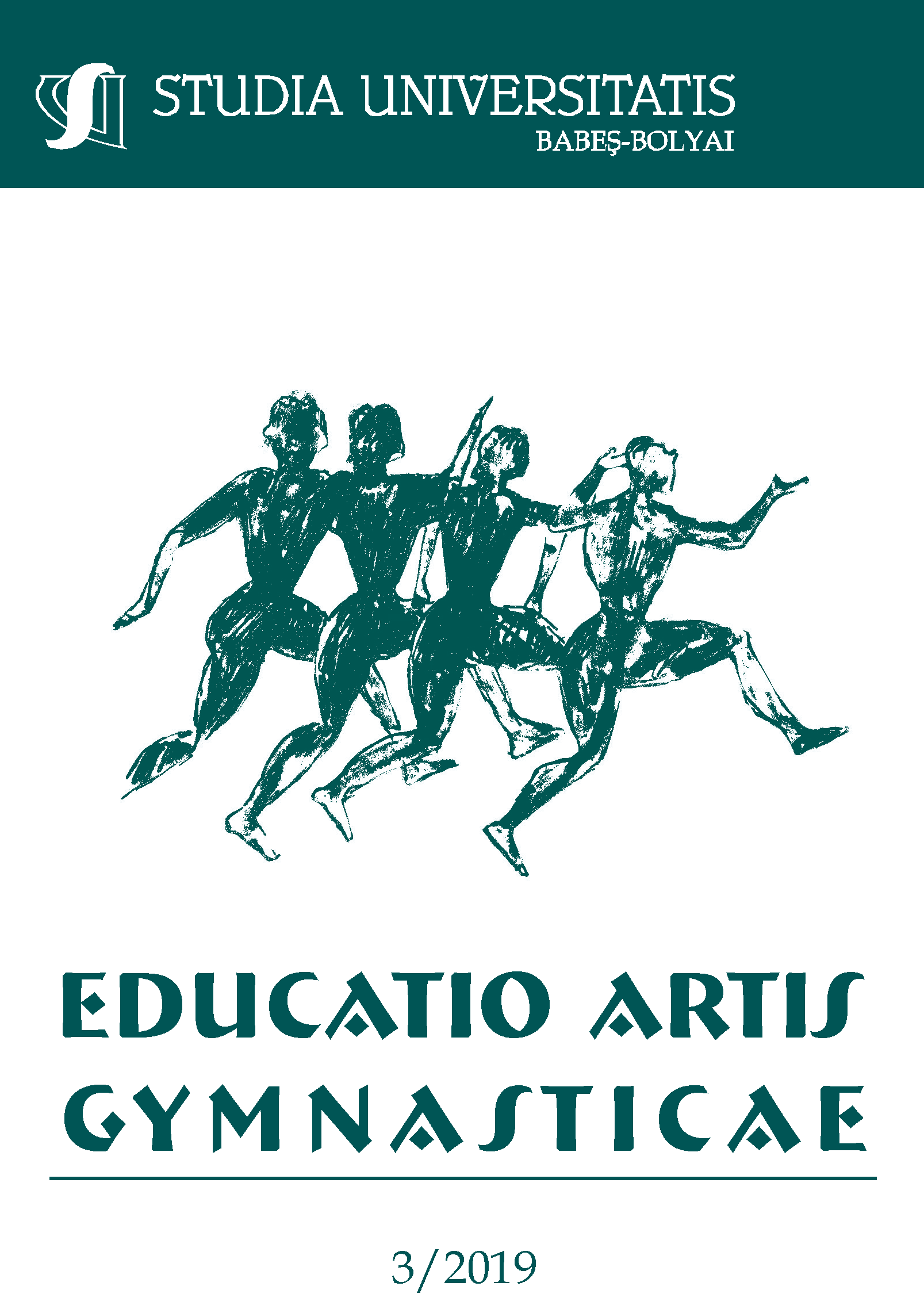FOREST ADVENTURE PARKS OF ROMANIA: NEW POSSIBILITIES TO DEVELOP THE HUMAN PHYSICAL CAPACITY
DOI:
https://doi.org/10.24193/subbeag.64(3).24Keywords:
adventure park; climbing; physical benefits; motor skill, rope courses.Abstract
One of the primary goals of physical education is to improve the human physical capacity. The physical capacity is a dynamic potential of a person, which is composed by the level of motor abilities and motor skills acquired during life. School-based physical education plays an important role in the development of motor capacity, but it is by far not enough to achieve the goal of physical education. Purpose: The purpose of this study is to map the adventure parks of Romania and to examine (by reviewing the literature) the effect of climbing on the motor capacity of the participants. We would like to examine the most common obstacles in adventure parks and determine what physical abilities are needed to complete them. Case Presentation: In Romania, the first forest adventure park was built in 2006 and by now, their number has reached thirty. Their main characteristic is that the climbers, by relying on their own physical and mental abilities, try to cross obstacles of various difficulty, height and length. Conclusions: Moving activities provided by forest adventure parks have become easily available to more and more people. Climbing in adventure parks (and climbing in general) can be an excellent alternative to improving motor capacity, as it uses and develops the body in a versatile way.
REZUMAT. Parcurile de aventură din România: noi posibilități pentru creșterea capacității motrice a omului. Unul dintre obiectivele primare ale educației fizice este dezvoltarea capacității motrice. Capacitatea motrică este un potențial dinamic, compus din nivelul de dezvoltare al calităților motrice și deprinderilor motrice. Educația fizică școlară are un rol important în dezvoltarea capacității motrice a elevilor, dar nu este suficientă pentru atingerea obiectivelor educației fizice. Scop: Scopul acestui studiu este prezentarea parcurilor de aventură din România și de a descrie (prin studiul literaturii de specialitate) efectul cățărării asupra capacității motrice. Am dori să descriem cele mai comune obstacole din parcurile de aventură și să determinăm acele calități și deprinderi motrice care se implică în cățărare. Rezultate: În România, primul parc de aventură forestier a fost construit în 2006 și până acum numărul lor a ajuns la treizeci. Principala lor caracteristică este că cățărătorii, bazându-se pe propriile abilități fizice și mentale, încearcă să traverseze obstacole de diferite dificultăți, înălțimi și lungimi. Concluzii: Activitățile motrice oferite de parcurile de aventură forestiere au devenit accesibile pentru tot mai mulți oameni. Cățărarea pe traseele cu obstacole (și cățărarea în general) poate fi o alternativă excelentă pentru îmbunătățirea capacității motrice.
Cuvinte cheie: parc de aventură; cățărare; beneficii fizice; deprindere motrică.
References
Attarian, A. (2001). Trends in outdoor adventure education. The Journal of Experiential Education, 24(3), 141-149.
BabyCenter. (2013, October). Climbing and balancing: toddler development. Retrieved from Baby center: https://www.babycentre.co.uk/a556907/climbing-and-balancing-toddler-development
Cârstea, G. (1999). Metodica educaţiei fizice şcolare. București: Editura Academiei Naţionale de Educaţie Fizică şi Sport.
Cârstea, G. (2000). Teoria și metodica educației fizice și sportului. Bucharest: Editura AN-DA.
Deane, S. (2018, January 31). Health Benefits of an Aerial Ropes Course. Retrieved November 2018, from First Flight Adventure Park: http://www.firstflightadventurepark.com/top-health-benefits-of-the-ropes-course
Frost, J. (2013, Summer). Why Children Climb? Motivation, Process and Child Development. Playground Magazine, pp. 8-11. Retrieved from https://abcreative.net/wp-content/uploads/2013/10/Why-Children-Climb.pdf
Grigore, G. (2006, July 14). S-a deschis Primul parc de aventuri din Romania, ‘AVENTURA PARC’. Retrieved from Didactic.ro: https://www.didactic.ro/stiri/12047_s-a-deschis-primul-parc-de-aventuri-din-romania-aventura-parc
Hébert, G. (1912). Practical Guide of Physical Education. (PILOU, & GREGG, Trans.)
HighSports. (2016, September 6). Why is climbing great for children? Retrieved December 22, 2018, from Highsports since1994: http://www.high-sports.co.uk/blog/item/why-is-climbing-great-for-children.html
Janssen, I., & LeBlanc, A.G. (2010). Systematic review of the health benefits of physical activity and fitness in school-aged children and youth. International Journal of Behavioral Nutrition and Physical Activity, 7(40). doi:10.1186/1479-5868-7-40
Mitra, A., & Mogos, G. (1980). Metodica educației fizice școlare. București: Editura Sport-Turism.
Neill, J. (2004, August). History of Ropes Courses. Retrieved from Wilderdom: http://www.wilderdom.com/ropes/RopesHistory.html
Nunan, D., Mahtani, K.R., Roberts, N., & Heneghan, C. (2013). Physical activity for the prevention and treatment of major chronic disease: an overview of systematic reviews. Systrematic Reviews, 2(56). doi:10.1186/2046-4053-2-56
O’Keefe, J. (2012, November 27). Run for your life! At a comfortable pace, and not too far. Retrieved from Youtube: https://www.youtube.com/watch?v=Y6U728AZnV0
Panjan, A., & Sarabon, N. (2012). Review of Methods for the Evaluation of Human Body Balance. Sport Science Review, 19(5-6), 131-163.
Rockreef. (2017). Reducing Stress Levels, And Other Benefits Of Climbing. Retrieved from ROCKREEF: http://rockreef.co.uk/reducing-stress-levels-benefits-climbing/
Skywalker. (2018). The Benefits of High Ropes. Retrieved November 2018, from Skywalker Adventure Builders: https://www.skywab.com/en/blog-uk/1858-the-benefits-of-high-ropes-high-rope-courses-are-a-fun-and-exciting-way-to-get-outdoors-and-get-some
Steinberg, R. D. (2011). Mindfulness, psychological well-being, and rock climbing: An exploration of mindfulness in rock climbers and the potential for psychological benefit. The Wright Institute. ProQuest Dissertations Publishing.
Wagstaff, M. (n.d.). A History of Challenge Courses. Retrieved from https://c.ymcdn.com/sites/www.acctinfo.org/resource/resmgr/imported/HistoryOfCCourses.pdf
Watts, B., Coleman, B., Clure, C., Daggett, M., Gallagher, P., Sustrich, P., & Wilkins, B. (1999). Metabolic and cardiovascular responses during work on a high ropes course. Journal of Sports Medicine and Physical Fitness; Turin, 39(1), 37-41.
Wentworth, K. (2018, September 11). The Benefits of Climbing for Toddlers. Retrieved November 2018, from Pentagon for Learning and Play: https://www.pentagonplay.co.uk/news-and-info/benefits-climbing-toddlers
Wikipedia. (2019, January 20). Retrieved from Climbing: https://en.wikipedia.org/wiki/Climbing
Downloads
Published
How to Cite
Issue
Section
License
Copyright (c) 2019 Studia Universitatis Babeș-Bolyai Educatio Artis Gymnasticae

This work is licensed under a Creative Commons Attribution-NonCommercial-NoDerivatives 4.0 International License.






